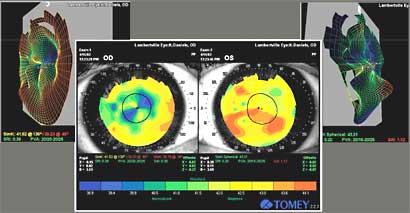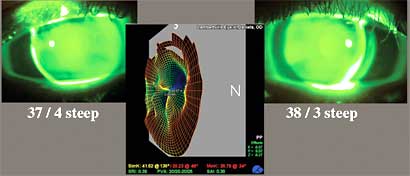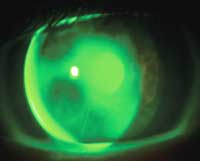Reverse geometry ortho-K lens effective for postrefractive surgical case
Contact Lenses and Eyewear
PW, a 46-year old male golf professional, underwent eight-incision radial keratotomy (RK) in December 1996. PW provided no preoperative information, but did report a postoperative infection. He had tried to wear gas-permeable lenses postoperatively, but significant contact lens decentration limited his wear time. His primary symptoms included glare, poor visual quality and reduced depth perception that interfered with his career as a professional golfer.
PW’s manifest refraction was +0.75 –0.75 x 050 with a visual acuity of 20/25+ in the right eye and plano –1.00 x 050 with a visual acuity of 20/20- in the left eye. The variable incision depth, length and width undoubtedly contributed to his postoperative topography irregularities.
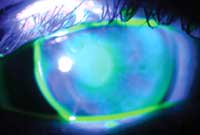 | 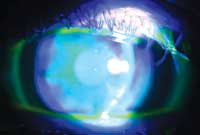 |
| Initial lenses: These are PW’s initial gas-permeable lenses post eight-incision RK. OD: 771/-2.25/8.8/9.8 (photo on left); OS: 760/1.37/8.0/9.2. Images: Daniels K | |
Patient refit with new GP lenses
We initially attempted a refit using a Reverse Geo Plateau Lens (Menicon, San Mateo, Calif.). While preoperative keratometry and refractive data is often valuable, no such information was available. Predicated on the fact that PW’s unaided preoperative reading distance was 10 to 12 inches, we estimated his myopia to have been 3 D to 4 D.
Using an orthokeratology philosophy, we chose diagnostic lenses that would afford a 3.5-D correction for a 45-D corneal curvature. This resulted in a fit defined by central optic zone vaulting, minimal incision bearing and adequate edge lift. An optimal fit was ultimately achieved with a 38-D base curve/41-D secondary curve in the right eye and 37-D base curve/41-D secondary curve in the left eye.
While PW was relatively happy with the resulting comfort and vision, each lens still decentered nasally. A second trial was initiated with a Dyna Z Intralimbal GP (Lens Dynamics, Golden, Colo.) in an attempt to vault the central cornea and gradually taper to an alignment fit peripherally. Final lens parameters were 7.67 11.2/9.4 –1.25D in both eyes. While some decentration persisted, these lenses provided 20/20 visual acuity, good comfort and a more stable fit.
|
|
Refractive surgery: Oblate geometry, decentration
Both incisional RK and ablative PRK, LASEK and LASIK procedures can result in an oblate geometry and decentered treatment zone, causing diurnal fluctuations, monocular diplopia or nighttime halos and ghosting. In addressing the physical fit and visual needs of these postoperative patients, large tetra-curve gas-permeable lenses of approximately 11.85 mm (SD 0.16 mm) are often more beneficial than standard design gas-permeable lenses.
These larger diameter designs, in combination with an optic zone at least 0.2 mm larger than the refractive treatment zone, stabilize the fit and optimize vision. The refractive treatment zone is 3 mm to 5 mm in RK and up to 7 mm in ablative surgery. In fact, gas-permeable lenses are seen as more successful and sometimes the only alternative for patients with surgically induced irregular astigmatism. Although there is no prescribing philosophy for postoperative corneas, vaulting the treatment area with gas-permeable lenses is successful in about 50% of the cases.
Base curve selection for postrefractive gas-permeable lens fitting should be based upon a combination of preoperative topography and refractive findings. If this data is not available, select a base curve based on postoperative corneal topography at an inflection point 3.5 mm superior to fixation. The goal is a well-centered lens with midperipheral alignment and apical pooling.
Occasionally, as was the case with PW, a standard large-diameter multi-curve design will not meet our prescribing criteria, in which case a more sophisticated design is indicated. In particular, reverse geometry or intralimbal designs may be necessary.
Reverse geometry designs
|
|
Reverse geometry designs are used for two reasons: To accommodate the surgically induced oblate corneal curvature and provide an orthokeratologic effect for those patients with residual myopia. This method works well on abrupt corneal contour changes at the edge of the treatment zone, surgically induced peripheral asymmetries and a histories of preoperative spherical peripheral cornea (low eccentricity).
Reverse geometry gas-permeable designs use large diameters of 10.0 mm to 11.5 mm and hyper Dk polymers. Optic zones are often small and vary from 5 mm to 6.5 mm. Secondary curves are often 2 D to 4 D steeper than the base curve radius. Fundamentally, reverse geometry lenses are designed to align the central optic zone with the surgical treatment zone while providing a peripheral curve system that tangentially contours the “unoperated” peripheral corneal.
When prescribing reverse geometry lenses, the initial base curve can be selected using several methods. The simplest approach is based on preoperative topography, matching the base curve to the desired myopic correction as if performing orthokeratology.
The second approach uses postoperative topography with gas-permeable fitting software to simulate fluorescein patterns.
A final, albeit more tedious approach, is to calculate the lens curves based on postoperative topography/keratometry data. Start by averaging the central flatter, 1.5-mm area values for base curve selection and repeat for the paracentral 3.5 mm to 5 mm area to determine the steeper secondary curves.
Intralimbal designs
Intralimbal designs are ultra-large gas-permeable lenses (10.8 mm to 12.0 mm) available in a variety of high-Dk polymers. These lenses are designed to fit within the limbus as opposed to a semi-scleral design. They feature a large optic zone, greater than 8.5 mm, which vaults the surgical treatment zone. These lenses do not always use reverse geometry peripheral curves. The vaulting optic zone and complementary peripheral curves provide a tangential relationship with the peripheral cornea.
In summary, PW was fit with a reverse geometry orthokeratology design that performed better than his original gas-permeable design. However, in this particular case, the larger intralimbal design fostered a better level of centration and stability.
For more information:
- Kenneth Daniels, OD, FAAO, in private practice in New Jersey, is an adjunct assistant clinical professor at the Pennsylvania College of Optometry and is a National Eye Institute investigator in the Collaborative Longitudinal Evaluation of Keratoconus study. He can be reached at Hopewell-Lambertville Eye Associates, 84 East Broad St., Hopewell, NJ 08525; (609) 466-0055; fax: (609) 466-3329; e-mail: kennethdaniels@att.net. Dr. Daniels has no direct financial interest in the products mentioned in this article, nor is he a paid consultant for any companies mentioned.
References:
- Alio JL, Belda JI, Artola A, Garcia-Lledo M, Osman A. Contact lens fitting to correct irregular astigmatism after corneal refractive surgery. J Cataract Refract Surg. October 2002;28:1750-1757.
- Astin CL, Gatry DS, McG-Steele AD. Contact lens fitting after photorefractive keratectomy. Br J Ophthal. 1996;80:597-603.
- Eggink FA, Beekhuis WH, Nuijts RM. Rigid gas-permeable contact lens fitting in LASIK patients for the correction of multifocal corneas. Graefes Arch Clin Exp Ophthalmol. June 2001;239:361-366.
- Koffler BH, Smith VM, Clements LD. Achieving additional myopic correction in undercorrected radial keratotomy eyes using the Lexington RK splint design. CLAO J. January 1999;25:21-27.
- Shivitz IA. Fitting contact lenses after radial keratotomy. Contact Lens Forum. December 1988;38-39.

